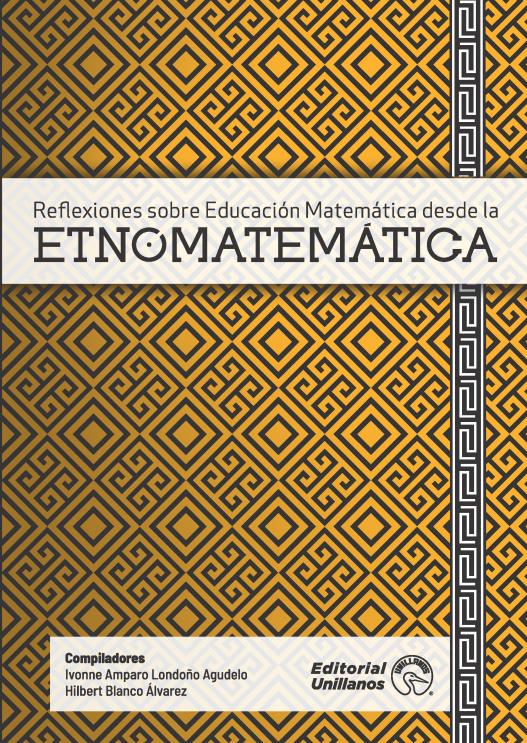Reflexiones sobre educación matemática desde la etnomatemática

Published
License

This work is licensed under a Creative Commons Attribution-NonCommercial-ShareAlike 4.0 International License.
ISBN PDF
ISBN-13
ISBN Libro físico
ISBN-13
How to Cite
Keywords:
Mathematics - Study and teachingPedagogical practices
Mathematics education
Ethnomathematics
Abstract
Chapters
-
Preliminares
-
1. Una experiencia desde la formación de maestros el caso de la Universidad de los Llanos
##submission.resume.a##
##submission.resume.a##This chapter presents the experience lived in the Bachelor's degree program in Mathematics at the Universidad de los Llanos, in the second semester of 2020, when developing the Ethnomathematics course. Due to the pandemic, there was a change of methodology in the course, which generated the opportunity for the realization of the cycle of lectures Ethnomathematics and the formation of the Bachelor in Mathematics. The students express in their narratives that the experience in the course, to the extent that there was dialogue with academics and among peers, provoked processes of transformation in their perceptions about Ethnomathematics. This generated changes in their training as future mathematics teachers, in the recognition of their cultural identity, in the importance of recognizing the mathematical knowledge immersed in the socio-cultural environments of the students and in the conception of a static mathematics to a dynamic mathematics as a product of social construction (Blanco-Álvarez, 2011).
-
2. Etnomodelación como una acción pedagógica para la matematización de las prácticas matemáticas
##submission.resume.a##
##submission.resume.a##The use of ethnomathematical techniques and modeling tools allows examining real systems and understanding the various holistic ways of doing mathematics. This pedagogical approach connects the cultural diversity present in local mathematics and is best represented by ethnomodeling, which translates and elaborates local problems into global mathematical practices, including everyday, school and academic knowledge. Ethnomodeling studies mathematical ideas in their cultural context, relating mathematical modeling to ethnomathematics, and uses the mathematization of everyday life to strengthen cultural identity and broaden mathematical knowledge. Thus, it is an effective strategy to bring school and everyday knowledge closer together.
-
3. El concepto de etnografía matemática
##submission.resume.a##
##submission.resume.a##The concept of mathematical ethnography is based on what is presented, in a first attempt, in Aroca (2018). The fundamental purpose of this new proposal is to present a research method, not only for the Ethnomathematics Program, but for any approach to mathematics education that seeks to know the forms of expression of mathematical knowledge and knowledge that are produced in a cultural context other than the classroom and, especially, in the craft. We propose that the concept of mathematical ethnography be a research method of the Ethnomathematics Program.
-
4. Clasificación de actividades matemáticas diseñadas desde la Etnomatemática
##submission.resume.a##
##submission.resume.a##A tool is introduced for the classification of mathematical activities designed from ethnomathematics, dividing them into three levels: 1) Motivational/Exploratory, 2) Political/Valuation and 3) Amplifier/Articulator. This classification instrument has 27 indicators, grouped into seven dimensions. An example of the application of this tool is presented with an ethnomathematical activity aimed at Peruvian students in the sixth grade of basic education. It is concluded that the activity belongs to level 1: Motivational/Exploratory.
-
5. Una experiencia en el diseño y la evaluación de textos de matemáticas con enfoque etnomatemático
##submission.resume.a##
##submission.resume.a##This paper shares an experience in the design and evaluation of a seventh grade mathematics text for the Bribri-Cabécar indigenous territory of Costa Rica, in the period 2014-2020. This text represents one of the products of the FUNDER ethnomathematics project of the Sarapiquí campus of the National University, which aimed to strengthen the teaching of mathematics with an ethnomathematics approach in the Regional Directorate of Education Sulá de Talamanca. This product is based on the ethnomathematics research program of D'Ambrosio (2008) and methodologically is based on the didactic suitability of the ontosemiotic approach of Godino (2011). The eight moments of the participatory construction process of the draft of this text, its evaluation under the methodology called “360° approach” and its final result are shared.
-
6. La emancipación en la educación matemática indígena en el Amazonas una mirada desde la etnomatemática
##submission.resume.a##
##submission.resume.a##This chapter presents a critical reading of a master's thesis that sought, through the study of the knowledge and processes of weaving mats and baskets, to improve the teaching and learning process of mathematics in an indigenous Ticuna school in the Amazon. The analysis was carried out from the category of emancipation, associated with the social dimension present in the research that has worked on the relationship between ethnomathematics-indigenous education-curriculum. As a result, it was found that, although some points tending to a process of emancipation are made, these remain in the background, since the focus of the research is on reproducing the legitimacy and superiority of school mathematical knowledge over cultural knowledge, categorized only as notional and, consequently, the need for public discussion of the meanings of mathematics education in its dialogic construction with indigenous knowledge and the obstacles and tensions it faces is evidenced.
-
7. Matemáticas como educación para la paz proposiciones imperfectas
##submission.resume.a##
##submission.resume.a##The present text gathers the four points presented on September 8, 2020 at the Universidad de los Llanos, within the framework of the Ethnomathematics course, with the support of the International Network of Ethnomathematics. The lecture was titled as it appears in this chapter and is aligned with the author's doctoral work, in the interinstitutional doctoral program in Education at the Universidad del Valle. Peace education (PE) as an epistemic field, 2. Characteristics of peace education, 3. Mathematical questions in relation to peace, and 4. Imperfect propositions: mathematics as peace education. In this text we will give depth to the first and third components that constitute the referential axes of the doctoral work.
-
8. Prácticas pedagógicas investigativas desde una perspectiva etnomatemática
##submission.resume.a##
##submission.resume.a##The objective of this article is to present the results obtained from the development of pedagogical research practices, directed to students of a group of Brazilian elementary schools. Having as theoretical-methodological referential the field of ethnomathematics, in its intersections with the ideas of Michel Foucault and the production of the maturity of Ludwig Wittgenstein, the research materials consisted of classes taught and, subsequently, transcribed, in addition to materials produced by the students. By means of the analysis from the Foucauldian perspective, it was possible to evidence the existence of different mathematical language games in the classes of the initial years of fundamental education. Such results have allowed, on the one hand, the emergence of other topics related to the field of ethnomathematics, such as studies of the deaf community and evaluative processes and, on the other hand, the existence of tensions in relation to mathematics teaching processes.
-
9. Algunos lugares comunes en las investigaciones etnomatemáticas
##submission.resume.a##
##submission.resume.a##This article aims to help the debate on some tensions and polarities in ethnomathematics by mentioning certain aspects in ethnomathematical research that meet the definition of common place, in order to make some reflections on them. We ask questions such as What commonplaces is this community visiting, how is the community dealing with those commonplaces? The text has two parts, the first indicates what to assume as commonplace and the second provides a list of commonplaces in ethnomathematics, the ways in which they are expressed and the lines of escape to such places.





